Haworthias have beautiful leaves that stay intact if they get the proper care. The leaves grow in clumps, open, and close. However, if a plant, whose leaves are supposed to grow open, closes up, it indicates some problem.
Haworthia generally closes up due to stress, and it could be mainly due to incorrect watering, exposure to the sun, or adverse temperatures. To revive a haworthia that is closing up, sparingly water the plant, give them partial sunlight, and protect them from unfavorable temperatures.
Haworthias are indeed hard to kill, but they are tender succulents. A harsh environment is not their thing.
Today, I will explain the reasons behind Haworthia closing up. I will also share the solutions to the problem so that Haworthias can easily come back to their original form.
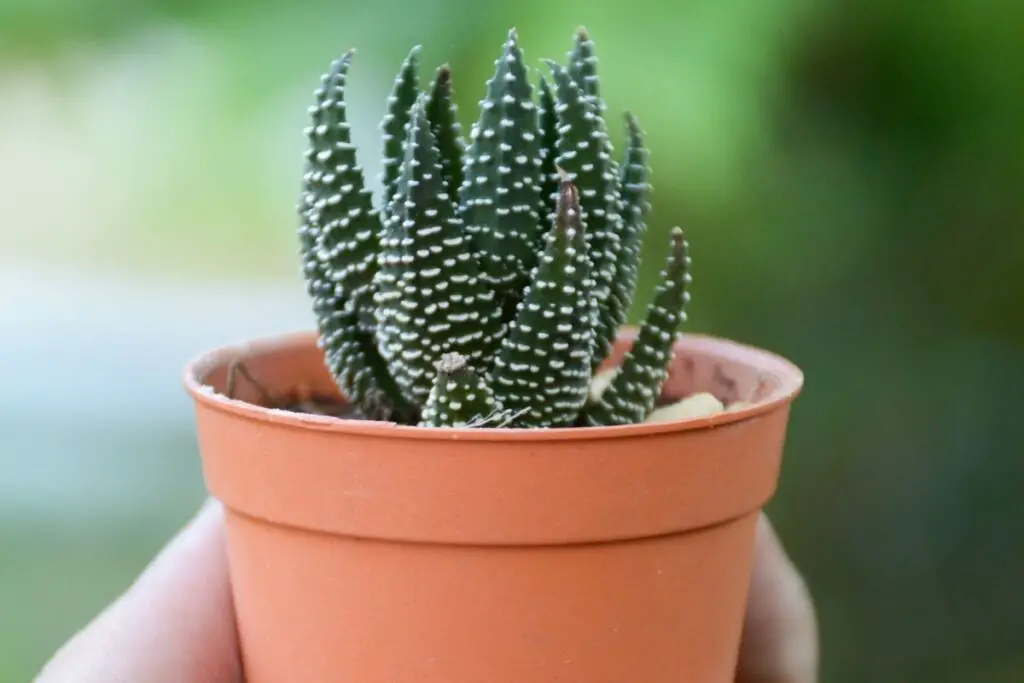
Why is my Haworthia closing up?
Haworthia leaves will generally close up when they face undesirable conditions around themselves.
Other than that, it can also happen if you are not giving them the ideal care.
The main reasons are inadequate light, water, and temperature issues.
There are other reasons too.
These unfavorable conditions stress the plant and make them close up.
However, some varieties naturally close up, and that’s not a problem.
Wrong supply of water
Giving the right amount and frequency of water to Haworthias is easy yet tricky at the same time.
Even experienced gardeners make this mistake at some point.
Beginners make this mistake more often and are completely unaware of the right way to solve the issue without killing the succulent.
You should know that Haworthias can store water in their leaves, and they naturally grow in dry areas where water is spare.
Moreover, being slow-growers, they absorb water slowly.
Watering too much can lead to overwatering and result in root rot.
You must let the soil dry out before watering.
Most people ignore watering because they think that Haworthias can stay without water for months due to their water storage capacity.
Eventually, all the plants, even these succulents, will require watering to stay healthy.
If you take them for granted and keep them thirsty for months, they will close up due to underwatering.
Sometimes the signs of both the issues are the same.
To understand the exact reason and differentiate both the problems, they will show some distinctive signs:
- In overwatering, along with closing up, the leaves will become yellow or brown and mushy.
- In underwatering, a closed plant is accompanied by curled up and red leaves.
Fixation: Water Haworthias when the soil’s top 2-3 inches feels dry.
Checking the moisture level before watering helps you to understand their watering needs.
You can also know the time they take to dry and the time gap to keep between watering.
Also read: How Often To Water Haworthia? (Haworthia Water Requirements)
Imbalanced sun exposure
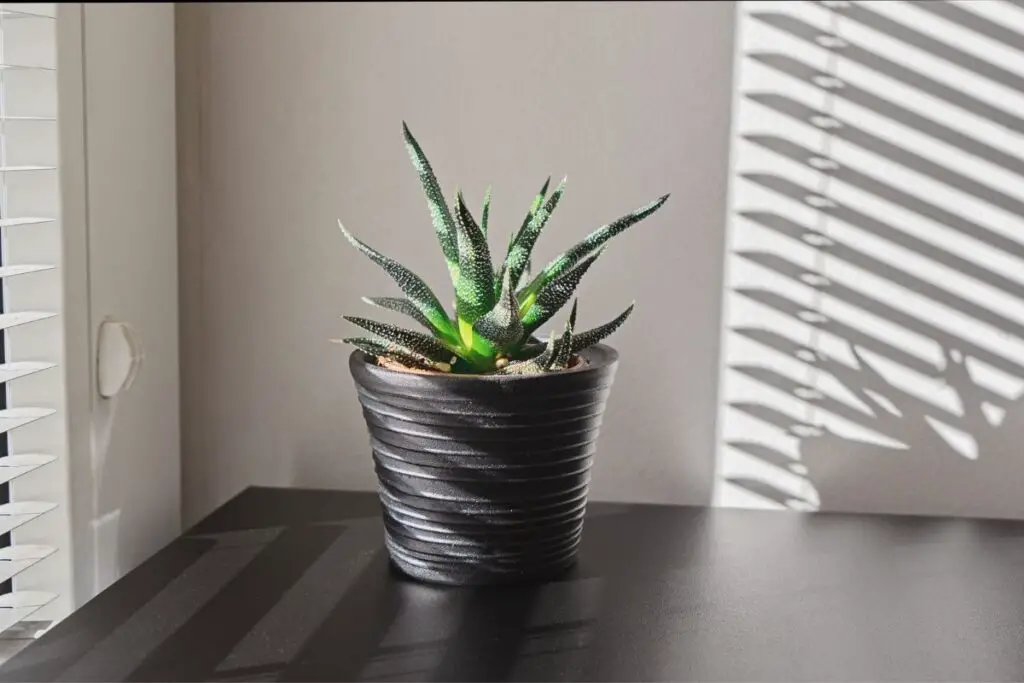
Haworthias indeed require sunlight, but filtered or indirect.
Exposure to direct sun also increases the temperature, and they close to protect themselves from the heat.
The foliage will also turn white, yellow, or red.
Eventually, they get burnt and turn brown at the tips.
Sometimes these signs are mistaken as underwatering signs.
But it is caused by too much exposure to harsh direct sunlight.
Fixation: You must know that these plants require bright indirect sunlight to thrive.
Put on shading nets or cloths over your outdoor Haworthia garden bed.
You can also keep potted sun-loving plants to guard them.
For indoor plants, put on sheer curtains if the plant is getting too much sunlight.
Within a few weeks, the leaves will be back in their position.
Also read: How Much Light Does Haworthia Need? (Haworthia Light Requirements)
Looking for gardening supplies? We have tested 100's of products before recommending them to you guys. Check out our best pick below:
| Image | Gardening Supplies | Best Price? |
|---|---|---|
 Top
Top Top
Top | Raised Garden Bed Kit | Check On Amazon |
 | XLUX Soil Moisture Meter, Plant Water Monitor, Soil Hygrometer Sensor for Gardening, Farming, Indoor and Outdoor Plants, No Batteries Required | No Results |
 Top
Top Top
Top | 82 Pcs Garden Tools Set and Extra Succulent Tools Set | Check On Amazon |
 | Joeys Garden Expandable Garden Hose with 8 Function Hose Nozzle, Lightweight Anti-Kink Flexible Garden Hoses, Extra Strength Fabric with Double Latex Core, (50 FT, Black) | No Results |
 Top
Top Top
Top | Dual Chamber Compost Tumbler | Check On Amazon |
 Top
Top Top
Top | Sunnyglade Plant Stakes | Check On Amazon |
 Top
Top Top
Top | Organic Cold Pressed Neem Seed Oil | Check On Amazon |
 Top
Top Top
Top | Mighty Mint Gallon :-Insect and Pest Control Peppermint Oil | Check On Amazon |
 Top
Top Top
Top | Scotts DiseaseEx Lawn Fungicide | Check On Amazon |
 Top
Top Top
Top | Jacks Classic 20-20-20 All Purpose Fertilizer | Check On Amazon |
 Top
Top Top
Top | 30,000 Seeds Pollinator Attracting Wildflower Mixture | Check On Amazon |
 Top
Top Top
Top | Survival Vegetable Seeds Garden Kit-Over 16,000 Seeds | Check On Amazon |
Adverse temperatures
The temperature in your area or the plant’s surroundings also plays a major role behind closed Haworthia.
Haworthia will get closed if the temperature around feels overheated if the heat is too much.
Even if you shade clothes to filter the sunlight, they will still get closed because the surrounding environment is still hot.
In such conditions, Haworthia tries to protect itself from the heat.
Fixation: It happens mostly when high temperatures, hot summers, and harsh sun are active.
Be very careful with watering.
Outside, there is nothing to do much other than shade clothes to filter the sun.
For indoor plants, keep them away from air conditions, direct ceiling fans, heaters, radiators, fireplaces, bathrooms, or kitchens.
These are some places that can give the plant temperature stress.
Water them sparingly in such weather – when the soil gets fully dry.
It helps keep the roots cool, control the temperature to some extent and bring the plant’s original structure back.
Also read: Haworthia Temperature Tolerance: High And Low-Temperature Guide
Poor soil and drainage
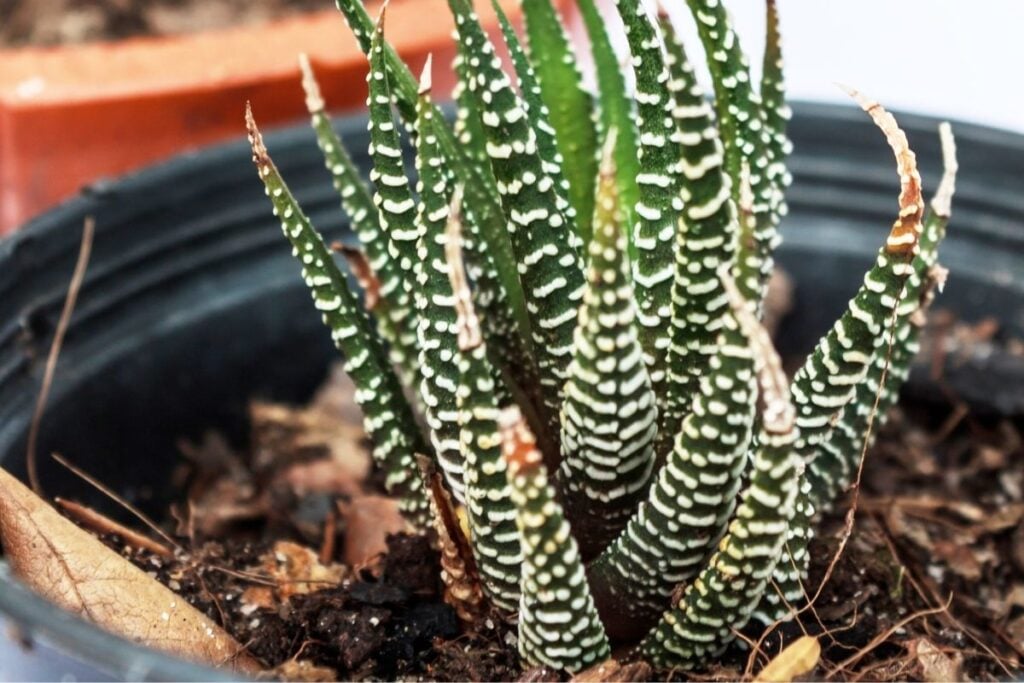
A soil poor in quality or drainage can also make Haworthias close their leaves.
A soil poor in drainage also causes overwatering because the water you give remains in the soil and keeps the roots wet for a long time.
If you have kept Haworthias in pots, they must have drainage holes.
Otherwise, the water will remain stagnant in the soil, wet the roots, and cause overwatering and root rot.
A drainage hole of an appropriate size helps easily flow out of the excess water and adequate ventilation.
Ventilation can also support quick drying of the soil to some extent.
The drainage problem rarely makes the Haworthia close their leaves.
If the problem occurs, it will be visible within one week.
The leaves will become yellow, brown, and mushy if it extends.
Fixation: Use well-drained soil with an ideal pH level.
Add materials like poultry grit, horticultural pumice, perlite, aquarium gravel, and coarse sand to improve the drainage.
Use a container with a drainage hole.
For more improvement, use terracotta pots.
It is made of porous material and wicks away moisture very quickly.
Also read: What Soil To Use For Haworthia? (+Ideal Soil Mix)
Natural closing up
Some varieties of Haworthia, for example, Haworthia Reinwardtii and Haworthia Coarctata, close up naturally.
That is their natural growth form and structure.
The leaves stay compact and closed; the tips are quite long and sharp, resembling claws.
Some varieties of Coarctata even have colorful tips like red or orange.
This closing is natural.
They grow like this from the beginning, and there is no solution.
How to revive a closed Haworthia?
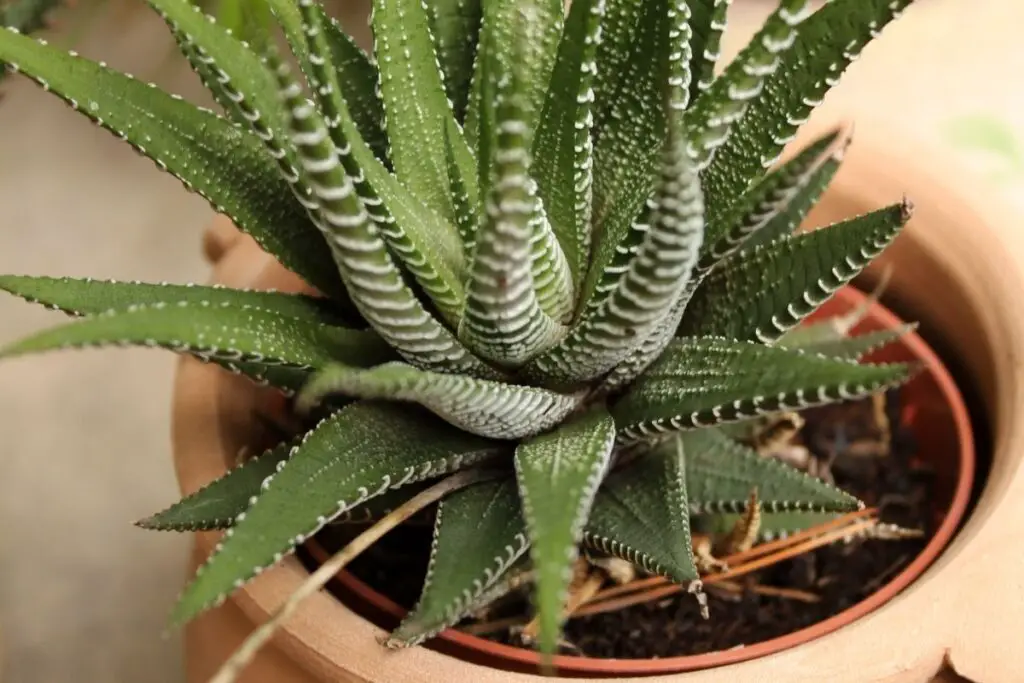
When you find Haworthias fine today and suddenly closed the next day, try every alternate thing like light, water, temperature, or drainage.
- They grow best under indirect sunlight. Put on shades instead of shifting them.
- Fertilize lightly with an appropriate fertilizer once in spring and fall.
- Also, check the pH level before use. Use well-drained soil with an ideal pH level.
- Also, ensure the drainage system of the container you choose for Haworthia.
- Protect them from adverse temperatures.
- Double-check the watering regime you follow. Instead of following a strict routine, check the soil moisture before. When the top 2-3 inches feel dry, the plant is ready to take water.
Below, I have shared the tips in detail that you need to follow to prevent Haworthia from closing.
The right type of soil
For potted plants, you can use commercial cactus soil.
They contain perlite and pumice that help in drainage.
If you want to prepare the soil for the pot or garden bed, you can try the following recommendations:
- 40% parts potting soil
- 40% parts small gravel
- 20% part perlite or pumice
For soilless mixes in containers:
- 50% gravel of appropriate size
- 50% of soil, coarse sand, and organic fertilizer
Make sure that the soil’s pH level remains between 6.6 and 7.5.
Potted Haworthias require pots with drainage holes.
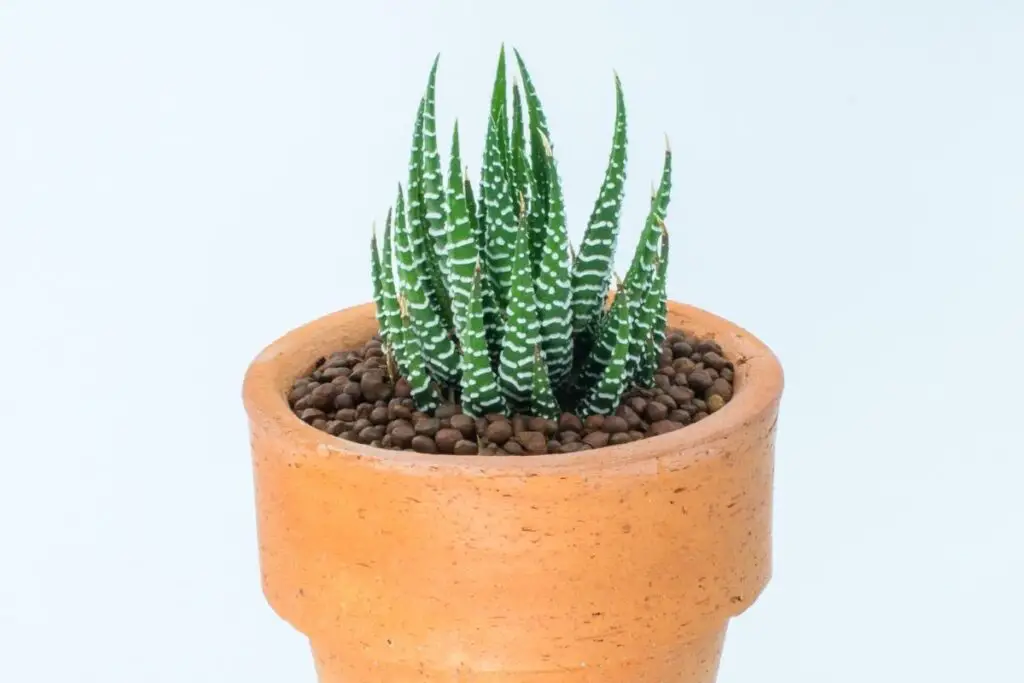
A container with a drainage hole helps in good drainage and adequate air circulation.
It guarantees the plant’s good health and lengthy lifespan.
You must check that the plant gets enough drainage and ventilation from the planter you choose.
It helps to drain out excess water and encourages enough airflow to the roots and soil.
The airflow also helps in the fast drying of the soil.
You can improve drainage further by using terracotta or clay pots.
Due to their porosity quality, moisture wicks away quickly, and it can save the plant from overwatering if you have done it mistakenly.
Watering the Haworthia
Watering can be very tricky for Haworthia.
For some people, a scheduled watering works, and for others, they need to check the soil’s moisture and then water these plants.
With daily practice, you can also excel in this matter.
In general, Haworthias will require more water to stay calm and hydrated.
Less water is required when the temperature is low as water takes time to evaporate.
However, when the high temperature gets accompanied by the hottest summer days, you must be careful with watering as Haworthias stay dormant.
We all know that in dormancy, a plant doesn’t require much watering as they need at other times.
So, you must be very careful and water sparingly, only when the soil feels dry.
Water the Haworthia when the soil’s top 2-3 inches get dry.
Don’t tell the whole soil to dry out; the lower portion of the soil must stay moist for hydrated roots.
Haworthias can stay without water for a long time. They need watering only once in 1-3 weeks.
It is one of their special features since they grow in warm temperatures in their native land over dry areas.
A balance between watering and temperature and sun
If your region has a warm climate and Haworthia stays outdoors under lots of bright indirect sunlight, they will advantage from good watering.
Watering them once in 1-2 weeks is a must. It keeps them cool.
It also won’t let the plant suffer from dehydration.
If your region receives cold weather and the plant is kept indoors in low light conditions, it will require less water.
Many people take Haworthias indoors during the winters to protect this tender succulent from cold injury.
Since the evaporation rate is slow, they will absorb water very slowly.
Water them once every 2-3 weeks, or once a month, depending on the drying speed of the soil.
Sun exposure
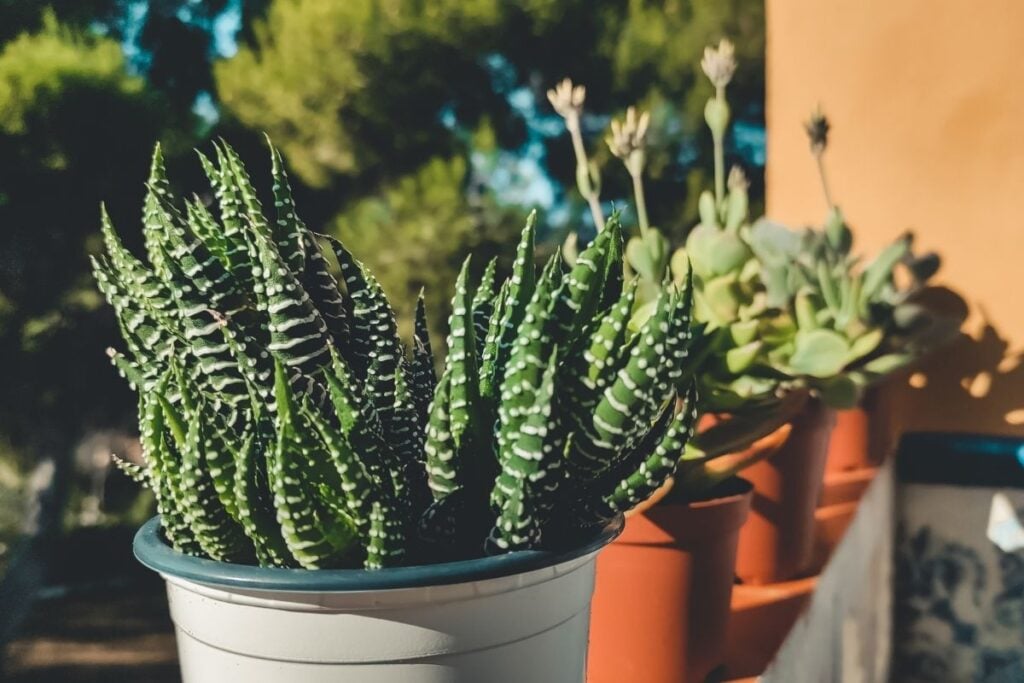
Haworthias thrive well under bright indirect sunlight.
However, 3-5 hours of direct sun in the morning will not harm them.
Instead, it keeps them healthy.
They can survive the direct sun of the early morning up to 11 am.
After that, put on the filter.
Put on easily removable shading nets, open them in the morning, and close them in the daytime.
For indoor plants, you can try the east or north-facing windows.
It gives soothing, direct sunlight in the morning.
As the day progresses, sunlight intensity decreases and fades.
If you don’t have these directions, you can keep them south or west-facing windows with sheer curtains to filter the light.
You can open it in the morning and put it on in the daytime after 11 am.
Also, keep the plant a few feet back when the heat increases.
You can also try artificial lights as they won’t burn the plants.
Use classical white cool fluorescent lights. Keep it on for 10-12 hours and then off.
For easy usage, buy a grow-light with a timer setting.
It also solves low light issues. Sometimes, they do undergo problems due to it indoors.
Final words
Though it is heartbreaking to see these attractive Haworthias not growing up to your expectations, you can treat the problem easily. Haworthia closing is not the end of the plant.
The reasons behind the problem are relatively general and not even life-threatening.
They will bounce back within a few weeks with little care and maintenance. You also don’t need to get impatient or frustrated because the solutions to the problems are straightforward.
With immediate action, you will not only see the Haworthias survive but flourish once their requirements get fulfilled.
Reference: The Haworthia Society, Botanical Studies, University of Wisconsin-Madison, Sciencedirect, Researchgate, Haworthia Study.
